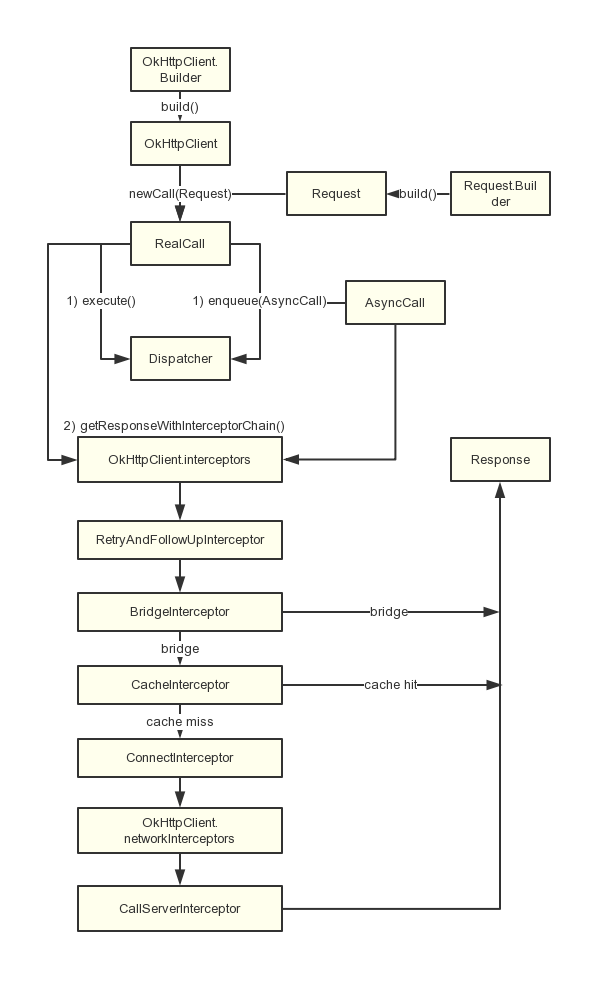终于懂了系列之OKHTTP源码解析
本章主要介绍 OkHttp的实现,代码基于okhttp-3.8.0
使用 OkHttp实现 GET请求非常简单,例子如下:
public class GetExample {
OkHttpClient client = new OkHttpClient();
String run(String url) throws IOException {
Request request = new Request.Builder()
.url(url)
.build();
try (Response response = client.newCall(request).execute()) {
return response.body().string();
}
}
public static void main(String[] args) throws IOException {
GetExample example = new GetExample();
String response = example.run("https://raw.github.com/square/okhttp/master/README.md");
System.out.println(response);
}
}
这个简单的例子,展示了OkHttp的使用过程:
- 创建
OkHttpClient对象 - 构造请求
Request - 调用
OkHttpClient发送Request - 解析请求结果
下面,我们以这个简单的例子为切入点,开始分析OkHttp内部的实现。
1. OkHttpClient以及Request的构造器
先看看 OkHttpClient 的构造器:
public OkHttpClient() {
// 使用默认的 Builder 初始化 OkHttpClient
this(new Builder());
}
OkHttpClient(Builder builder) {
// 从 Builder 中获取并初始化各个属性
this.dispatcher = builder.dispatcher;
this.proxy = builder.proxy;
this.protocols = builder.protocols;
this.connectionSpecs = builder.connectionSpecs;
this.interceptors = Util.immutableList(builder.interceptors);
this.networkInterceptors = Util.immutableList(builder.networkInterceptors);
this.eventListenerFactory = builder.eventListenerFactory;
this.proxySelector = builder.proxySelector;
this.cookieJar = builder.cookieJar;
this.cache = builder.cache;
this.internalCache = builder.internalCache;
this.socketFactory = builder.socketFactory;
boolean isTLS = false;
// 检查 connectionSpecs 是否包含 TLS 配置
for (ConnectionSpec spec : connectionSpecs) {
isTLS = isTLS || spec.isTls();
}
// 如果用户提供了 sslSocketFactory 或者不需要 TLS,则使用 builder 中的配置
if (builder.sslSocketFactory != null || !isTLS) {
this.sslSocketFactory = builder.sslSocketFactory;
this.certificateChainCleaner = builder.certificateChainCleaner;
} else {
// 否则使用系统默认的 SSL 配置
X509TrustManager trustManager = systemDefaultTrustManager();
this.sslSocketFactory = systemDefaultSslSocketFactory(trustManager);
this.certificateChainCleaner = CertificateChainCleaner.get(trustManager);
}
// 初始化剩余的属性
this.hostnameVerifier = builder.hostnameVerifier;
this.certificatePinner = builder.certificatePinner.withCertificateChainCleaner(
certificateChainCleaner);
this.proxyAuthenticator = builder.proxyAuthenticator;
this.authenticator = builder.authenticator;
this.connectionPool = builder.connectionPool;
this.dns = builder.dns;
this.followSslRedirects = builder.followSslRedirects;
this.followRedirects = builder.followRedirects;
this.retryOnConnectionFailure = builder.retryOnConnectionFailure;
this.connectTimeout = builder.connectTimeout;
this.readTimeout = builder.readTimeout;
this.writeTimeout = builder.writeTimeout;
this.pingInterval = builder.pingInterval;
}
构造器实现很简单,在默认构造器中传入了一个 OkHttpClient.Builder 建造者对象,然后将其中的参数复制给自己。
在 OkHttpClient.Builder 的构造器中有很多默认的值,如下注释:
public Builder() {
dispatcher = new Dispatcher(); // 分发器,另有一个带线程池参数的构造器
protocols = DEFAULT_PROTOCOLS; // 支持的协议,默认为HTTP_2、HTTP_1_1
connectionSpecs = DEFAULT_CONNECTION_SPECS; // 传输层版本、连接协议
// 事件监听器,3.8版本set方法还是package级别的,暂时不能设置
eventListenerFactory = EventListener.factory(EventListener.NONE);
proxySelector = ProxySelector.getDefault(); // 代理选择器
cookieJar = CookieJar.NO_COOKIES; // 读写Cookie的容器
socketFactory = SocketFactory.getDefault(); // Socket工厂
hostnameVerifier = OkHostnameVerifier.INSTANCE;// 主机名验证器
certificatePinner = CertificatePinner.DEFAULT;
proxyAuthenticator = Authenticator.NONE; // 代理认证器
authenticator = Authenticator.NONE; // 本地认证器
connectionPool = new ConnectionPool(); // 连接池
dns = Dns.SYSTEM; // 域名
followSslRedirects = true; // SSL重定向
followRedirects = true; // 普通重定向
retryOnConnectionFailure = true; // 连接失败重试
connectTimeout = 10_000; // 连接超时时间
readTimeout = 10_000; // 读超时时间
writeTimeout = 10_000; // 写超时时间
pingInterval = 0;
}
上面各种属性都从名字大致可以知道是干啥用的。
此外,Request 的构造也很简单,字段如下:
final HttpUrl url; // 请求的url
final String method; // 请求方式
final Headers headers; // 请求头
final @Nullable RequestBody body; // 请求体
final Object tag; // 请求的tag
我们接着看 client.newCall(request).execute() 这一行代码。
首先是 OkHttpCient.newCall(Request) 方法:
/**
* Prepares the {@code request} to be executed at some point in the future.
*/
@Override public Call newCall(Request request) {
return new RealCall(this, request, false /* for web socket */);
}
这里创建了一个 RealCall 对象,而 RealCall 实现了 Call 接口。Call 接口声明如下:
public interface Call extends Cloneable {
/** 获得原始请求 */
Request request();
/** 同步执行请求 */
Response execute() throws IOException;
/** 异步执行请求 */
void enqueue(Callback responseCallback);
/** 尽可能取消请求。已经完成了的请求不能被取消 */
void cancel();
/**
* 调用了execute()或者enqueue(Callback)后都是true
*/
boolean isExecuted();
boolean isCanceled();
/** 创建一个新的、完全一样的Call对象,即使原对象状态为enqueued或者executed */
Call clone();
interface Factory {
Call newCall(Request request);
}
}
回到 RealCall ,看看它的构造器以及成员变量:
final OkHttpClient client;
final RetryAndFollowUpInterceptor retryAndFollowUpInterceptor;
final EventListener eventListener;
/** The application's original request unadulterated by redirects or auth headers. */
final Request originalRequest;
final boolean forWebSocket;
// Guarded by this.
private boolean executed;
RealCall(OkHttpClient client, Request originalRequest, boolean forWebSocket) {
// 事件监听器,默认为null,目前3.8版本也无法设置
final EventListener.Factory eventListenerFactory = client.eventListenerFactory();
this.client = client;
this.originalRequest = originalRequest;
this.forWebSocket = forWebSocket;
// 创建一个重试、重定向拦截器
this.retryAndFollowUpInterceptor = new RetryAndFollowUpInterceptor(client, forWebSocket);
// TODO(jwilson): this is unsafe publication and not threadsafe.
this.eventListener = eventListenerFactory.create(this);
}
3. RealCall.execute
接着看看重点 RealCall.execute 方法:
@Override public Response execute() throws IOException {
synchronized (this) {
if (executed) throw new IllegalStateException("Already Executed");
executed = true;
}
captureCallStackTrace();
try {
client.dispatcher().executed(this);
Response result = getResponseWithInterceptorChain();
if (result == null) throw new IOException("Canceled");
return result;
} finally {
client.dispatcher().finished(this);
}
}
在上面的方法中我们可以知道,一旦 Call.execute 方法被执行,那么其 executed 就会被设置为 true,如果多次调用就会报错。
然后调用 client.dispatcher().executed(this);,该方法就是将 call 加入到 Dispatcher.runningSyncCalls队列中,没有其他多余的代码:
/** Used by {@code Call#execute} to signal it is in-flight. */
synchronized void executed(RealCall call) {
runningSyncCalls.add(call);
}
接着调用 getResponseWithInterceptorChain 进行网络请求并获取Response,该方法是 OkHttp 中的最重要的方法,我们稍后在介绍 RealCall.enqueue方法时再一起说。
紧接着就是finally代码块里面的 client.dispatcher().finished(this)。该方法也很简单,就是 Call 执行完毕后将其从 Dispatcher.runningSyncCalls 队列中移除,见下面的代码;同时,如果 promoteCalls 为true(此处入参false),还会执行 promoteCalls 方法,此方法是给异步调用准备的,具体代码后面会谈到;最后如果 runningAsyncCalls、runningSyncCalls 这俩正在执行的同步、异步队列之和为0,说明dispatcher处理空闲状态,那么调用 idleCallback.run通知外界dispatcher已经空闲了,该方法目前仅在测试用例中发现。
/** Used by {@code Call#execute} to signal completion. */
void finished(RealCall call) {
finished(runningSyncCalls, call, false);
}
private <T> void finished(Deque<T> calls, T call, boolean promoteCalls) {
int runningCallsCount;
Runnable idleCallback;
synchronized (this) {
if (!calls.remove(call)) throw new AssertionError("Call wasn't in-flight!");
if (promoteCalls) promoteCalls();
runningCallsCount = runningCallsCount();
idleCallback = this.idleCallback;
}
if (runningCallsCount == 0 && idleCallback != null) {
idleCallback.run();
}
}
4. RealCall.enqueue
顺便也说一下 RealCall.enqueue的方法。
同 execute方法类似,一旦 Call.enqueue 方法被执行,那么其 executed 就会被设置为 true,如果多次调用就会报错。
然后调用
client.dispatcher().enqueue(new AsyncCall(responseCallback));
方法开始了异步调用。
@Override public void enqueue(Callback responseCallback) {
synchronized (this) {
if (executed) throw new IllegalStateException("Already Executed");
executed = true;
}
captureCallStackTrace();
client.dispatcher().enqueue(new AsyncCall(responseCallback));
}
这里先看一下 AsyncCall 的相关代码,enqueue 方法具体代码下面再说:
final class AsyncCall extends NamedRunnable {
private final Callback responseCallback;
AsyncCall(Callback responseCallback) {
super("OkHttp %s", redactedUrl());
this.responseCallback = responseCallback;
}
...
@Override protected void execute() {
...
}
}
AsyncCall 的父类 NamedRunnable 是一个有 name 属性的 Runnable 抽象类,在执行代码前,会将当前线程名设置为 name,执行完毕后恢复。
/**
* Runnable implementation which always sets its thread name.
*/
public abstract class NamedRunnable implements Runnable {
protected final String name;
public NamedRunnable(String format, Object... args) {
this.name = Util.format(format, args);
}
@Override public final void run() {
String oldName = Thread.currentThread().getName();
Thread.currentThread().setName(name);
try {
execute();
} finally {
Thread.currentThread().setName(oldName);
}
}
protected abstract void execute();
}
在了解了 AsyncCall 的大致结构,我们返回 Dispatcher.enqueue 方法:
void enqueue(RealCall.AsyncCall call) {
// 同步块,确保线程安全
synchronized(this) {
// 将异步调用添加到准备队列中
this.readyAsyncCalls.add(call);
}
// 提升并执行准备好的异步调用
this.promoteAndExecute();
}
private boolean promoteAndExecute() {
// 断言当前线程没有持有此对象的锁
assert !Thread.holdsLock(this);
// 创建一个可执行异步调用的列表
List<RealCall.AsyncCall> executableCalls = new ArrayList();
boolean isRunning;
RealCall.AsyncCall asyncCall;
// 同步块,确保线程安全
synchronized(this) {
// 获取准备队列的迭代器
Iterator<RealCall.AsyncCall> i = this.readyAsyncCalls.iterator();
// 无限循环,直到准备队列处理完毕
while(true) {
// 如果准备队列中还有异步调用
if (i.hasNext()) {
asyncCall = (RealCall.AsyncCall)i.next();
// 如果正在运行的异步调用数小于最大请求数
if (this.runningAsyncCalls.size() < this.maxRequests) {
// 如果当前主机的异步调用数小于每主机最大请求数
if (this.runningCallsForHost(asyncCall) < this.maxRequestsPerHost) {
// 从准备队列中移除此异步调用
i.remove();
// 将此异步调用添加到可执行列表中
executableCalls.add(asyncCall);
// 将此异步调用添加到正在运行队列中
this.runningAsyncCalls.add(asyncCall);
}
// 继续处理下一个异步调用
continue;
}
}
// 判断当前是否有正在运行的调用
isRunning = this.runningCallsCount() > 0;
break;
}
}
// 遍历可执行列表并执行每个异步调用
int i = 0;
for(int size = executableCalls.size(); i < size; ++i) {
asyncCall = (RealCall.AsyncCall)executableCalls.get(i);
// 在执行服务上执行异步调用
asyncCall.executeOn(this.executorService());
}
// 返回当前是否有正在运行的调用
return isRunning;
}
maxRequests 和 maxRequestsPerHost 都有默认值,且有setter方法可以设置具体值,两者的setter方法最后会执行 promoteCalls 方法尝试执行异步任务。
在 enqueue 方法中,首先将异步任务加到准备队列readyAsyncCalls中,紧接着就调用promoteAndExecute
接着在promoteAndExecute中,会遍历准备队列,检查「正在运行的异步请求数」以及「call对应的host上的异步请求数」是否达到了阈值。如果还没有达到阈值,那么加入到 runningAsyncCalls 队列中,同时开始执行请求;否则加入到 readyAsyncCalls 队列中进行等待。
这里出现了一个 executorService() ,这是一个单例实现的线程池,该线程池也可以在 Dispatcher 的构造器中注入。
/** Executes calls. Created lazily. */
private @Nullable ExecutorService executorService;
public Dispatcher(ExecutorService executorService) {
this.executorService = executorService;
}
public synchronized ExecutorService executorService() {
if (executorService == null) {
executorService = new ThreadPoolExecutor(0, Integer.MAX_VALUE, 60, TimeUnit.SECONDS,
new SynchronousQueue<Runnable>(), Util.threadFactory("OkHttp Dispatcher", false));
}
return executorService;
}
这里我们可以看出来,这是一个典型的 CachedThreadPool 。
这是一个线程数量不定的线程池,他只有非核心线程,并且其最大线程数为 Integer.MAX_VALUE 。线程池中的空闲线程都有超时机制,这个超时时常为60s,超过这个时间的闲置线程就会被回收。SynchronousQueue 可以简单的理解为一个无法存储元素的队列,因此这将导致任何任务都会立刻执行。
从其特性来看,这类线程池适合执行大量耗时较少的任务。当整个线程池处理闲置状态时,线程池中的线程都会因为超时而被停止,这个时候 CachedThreadPool 之中实际上是没有线程的,它几乎不占用任何系统资源。
void executeOn(ExecutorService executorService) {
// 断言当前线程没有持有 RealCall.this.client.dispatcher() 的锁
assert !Thread.holdsLock(RealCall.this.client.dispatcher());
// 定义一个布尔变量 success,用于标记任务是否成功提交
boolean success = false;
try {
// 尝试在给定的执行器服务上执行此任务
executorService.execute(this);
// 如果没有抛出异常,则标记任务提交成功
success = true;
} catch (RejectedExecutionException var8) {
// 如果执行被拒绝,捕获 RejectedExecutionException 异常
InterruptedIOException ioException = new InterruptedIOException("executor rejected");
// 将原始异常作为原因附加到新的 IOException 中
ioException.initCause(var8);
// 通知监听器调用失败
RealCall.this.eventListener.callFailed(RealCall.this, ioException);
// 回调响应失败
this.responseCallback.onFailure(RealCall.this, ioException);
} finally {
// 如果任务没有成功提交
if (!success) {
// 通知调度器此任务已完成
RealCall.this.client.dispatcher().finished(this);
}
}
}
提交到线程池后,AsyncCall.run 方法就会被调用,又因为 AsyncCall 继承了 NamedRunnable ,所以最后执行的是 AsyncCall.execute 方法:
protected void execute() {
boolean signalledCallback = false;
RealCall.this.timeout.enter();
try {
// 获取带有拦截器链的响应
Response response = RealCall.this.getResponseWithInterceptorChain();
// 检查请求是否已被取消
if (RealCall.this.retryAndFollowUpInterceptor.isCanceled()) {
// 标记已经回调
signalledCallback = true;
// 回调失败,传递取消异常
this.responseCallback.onFailure(RealCall.this, new IOException("Canceled"));
} else {
// 标记已经回调
signalledCallback = true;
// 回调成功,传递响应对象
this.responseCallback.onResponse(RealCall.this, response);
}
} catch (IOException var6) {
IOException e = RealCall.this.timeoutExit(var6);
if (signalledCallback) {
Platform.get().log(4, "Callback failure for " + RealCall.this.toLoggableString(), e);
} else {
RealCall.this.eventListener.callFailed(RealCall.this, e);
this.responseCallback.onFailure(RealCall.this, e);
}
} finally {
RealCall.this.client.dispatcher().finished(this);
}
}
首先调用 getResponseWithInterceptorChain 进行网络请求并获取Response,然后根据请求是否被取消,调用对应的回调方法。最后调用 client.dispatcher().finished(this) 方法在 runningAsyncCalls 方法中移除call,并尝试执行其他的异步方法。
我们先看 client.dispatcher().finished(this) 方法,最后再看 getResponseWithInterceptorChain 方法的实现:
private <T> void finished(Deque<T> calls, T call) {
Runnable idleCallback;
synchronized(this) {
if (!calls.remove(call)) {
throw new AssertionError("Call wasn't in-flight!");
}
idleCallback = this.idleCallback;
}
boolean isRunning = this.promoteAndExecute();
if (!isRunning && idleCallback != null) {
idleCallback.run();
}
}
private boolean promoteAndExecute() {
assert !Thread.holdsLock(this);
List<RealCall.AsyncCall> executableCalls = new ArrayList();
boolean isRunning;
RealCall.AsyncCall asyncCall;
synchronized(this) {
Iterator<RealCall.AsyncCall> i = this.readyAsyncCalls.iterator();
while(true) {
if (i.hasNext()) {
asyncCall = (RealCall.AsyncCall)i.next();
if (this.runningAsyncCalls.size() < this.maxRequests) {
if (this.runningCallsForHost(asyncCall) < this.maxRequestsPerHost) {
i.remove();
executableCalls.add(asyncCall);
this.runningAsyncCalls.add(asyncCall);
}
continue;
}
}
isRunning = this.runningCallsCount() > 0;
break;
}
}
int i = 0;
for(int size = executableCalls.size(); i < size; ++i) {
asyncCall = (RealCall.AsyncCall)executableCalls.get(i);
asyncCall.executeOn(this.executorService());
}
return isRunning;
}
finished 方法不用多说;promoteCalls 方法的代码也很清晰明了,这是一个将等待队列中的任务移到 runningAsyncCalls 且执行的过程。
5. getResponseWithInterceptorChain(重头戏)
最后,终于来到了 getResponseWithInterceptorChain方法,如下所示。
Response getResponseWithInterceptorChain() throws IOException {
List<Interceptor> interceptors = new ArrayList();
interceptors.addAll(this.client.interceptors());
interceptors.add(this.retryAndFollowUpInterceptor);
interceptors.add(new BridgeInterceptor(this.client.cookieJar()));
interceptors.add(new CacheInterceptor(this.client.internalCache()));
interceptors.add(new ConnectInterceptor(this.client));
if (!this.forWebSocket) {
interceptors.addAll(this.client.networkInterceptors());
}
interceptors.add(new CallServerInterceptor(this.forWebSocket));
Interceptor.Chain chain = new RealInterceptorChain(interceptors, (StreamAllocation)null, (HttpCodec)null, (RealConnection)null, 0, this.originalRequest, this, this.eventListener, this.client.connectTimeoutMillis(), this.client.readTimeoutMillis(), this.client.writeTimeoutMillis());
return chain.proceed(this.originalRequest);
}
首先将以下拦截器依次加入到List中:
- OkHttpClient设置的拦截器
interceptors() - 重试、重定向拦截器
RetryAndFollowUpInterceptor - 把用户请求转换为服务器请求、把服务器返响应转换为用户响应的
BridgeInterceptor - 读取缓存直接返回、将响应写入到缓存中的
CacheInterceptor - 与服务器建立连接的
ConnectInterceptor - OkHttpClient设置的网络拦截器
networkInterceptors() - 真正执行网络请求的
CallServerInterceptor
将所有的拦截器保存在 interceptors后,创建一个拦截器责任链 RealInterceptorChain,并调用其 proceed 开始处理网络请求。
下面解释一下责任链模式是如何表现出来的?
首先看上面创建 RealInterceptorChain 的方法以及 RealInterceptorChain的代码:
// RealCall.java
Interceptor.Chain chain = new RealInterceptorChain(
interceptors, null, null, null, 0, originalRequest);
return chain.proceed(originalRequest);
// RealInterceptorChain.java
public final class RealInterceptorChain implements Interceptor.Chain {
private final List<Interceptor> interceptors;
...
private final int index;
private final Request request;
public RealInterceptorChain(List<Interceptor> interceptors, StreamAllocation streamAllocation,
HttpCodec httpCodec, RealConnection connection, int index, Request request) {
this.interceptors = interceptors;
...
this.index = index;
this.request = request;
}
...
@Override public Response proceed(Request request) throws IOException {
return proceed(request, streamAllocation, httpCodec, connection);
}
public Response proceed(Request request, StreamAllocation streamAllocation, HttpCodec httpCodec,
RealConnection connection) throws IOException {
if (index >= interceptors.size()) throw new AssertionError();
...
// Call the next interceptor in the chain.
RealInterceptorChain next = new RealInterceptorChain(
interceptors, streamAllocation, httpCodec, connection, index + 1, request);
Interceptor interceptor = interceptors.get(index);
Response response = interceptor.intercept(next);
...
return response;
}
}
在不考虑 OkHttpClient.interceptor()的情况下,上面这段代码的解释如下:
- 在 getResponseWithInterceptorChain 创建了一个 index为0的 RealInterceptorChain(下称链),接着就调用了其 proceed方法
- 在 RealInterceptorChain.proceed方法中:index=0
- 创建了一个 index为index+1的链 next
- 然后对当前 index的拦截器(即 RetryAndFollowUpInterceptor)执行 interceptor.intercept(next)。
- 在 RetryAndFollowUpInterceptor 方法中执行了 chain.proceed方法,而这里的 chain是 RealInterceptorChain 实例,所以回到了 RealInterceptorChain.proceed方法中
- 此时
index=1,同理链条可以一直执行下去;index=2..n-1 - 直到遇到最后一个拦截器 CallServerInterceptor,因此这是最后一个拦截器了,因此链肯定不能继续下去,不然就报错了 if (index >= interceptors.size()) throw new AssertionError();,而且在 CallServerInterceptor.intercept方法中也所搜不到 proceed关键字。又因为这是最后一个拦截器,所以肯定是负责和服务器建立实际通讯的。
- Response的返回与Request相反,会从最后一个开始依次往前经过这些 Intercetor
下图为OkHttp工作的大致流程:

接下来,我们看一下各个拦截器具体的代码。
6. RetryAndFollowUpInterceptor
@Override public Response intercept(Chain chain) throws IOException {
Request request = chain.request();
streamAllocation = new StreamAllocation(
client.connectionPool(), createAddress(request.url()), callStackTrace);
int followUpCount = 0;
Response priorResponse = null;
while (true) {
if (canceled) {
streamAllocation.release();
throw new IOException("Canceled");
}
Response response = null;
boolean releaseConnection = true;
// 1️⃣
try {
response = ((RealInterceptorChain) chain).proceed(request, streamAllocation, null, null);
releaseConnection = false;
} catch (RouteException e) {
// The attempt to connect via a route failed. The request will not have been sent.
if (!recover(e.getLastConnectException(), false, request)) {
throw e.getLastConnectException();
}
releaseConnection = false;
continue;
} catch (IOException e) {
// An attempt to communicate with a server failed. The request may have been sent.
boolean requestSendStarted = !(e instanceof ConnectionShutdownException);
if (!recover(e, requestSendStarted, request)) throw e;
releaseConnection = false;
continue;
} finally {
// We're throwing an unchecked exception. Release any resources.
if (releaseConnection) {
streamAllocation.streamFailed(null);
streamAllocation.release();
}
}
// 2️⃣
// Attach the prior response if it exists. Such responses never have a body.
if (priorResponse != null) {
response = response.newBuilder()
.priorResponse(priorResponse.newBuilder()
.body(null)
.build())
.build();
}
// 3️⃣
Request followUp = followUpRequest(response);
if (followUp == null) {
if (!forWebSocket) {
streamAllocation.release();
}
return response;
}
closeQuietly(response.body());
if (++followUpCount > MAX_FOLLOW_UPS) {
streamAllocation.release();
throw new ProtocolException("Too many follow-up requests: " + followUpCount);
}
if (followUp.body() instanceof UnrepeatableRequestBody) {
streamAllocation.release();
throw new HttpRetryException("Cannot retry streamed HTTP body", response.code());
}
if (!sameConnection(response, followUp.url())) {
streamAllocation.release();
streamAllocation = new StreamAllocation(
client.connectionPool(), createAddress(followUp.url()), callStackTrace);
} else if (streamAllocation.codec() != null) {
throw new IllegalStateException("Closing the body of " + response
+ " didn't close its backing stream. Bad interceptor?");
}
request = followUp;
priorResponse = response;
}
}
上面这些代码比较简单
- 首先正常进行请求,如果遇到了异常,根据情况看是否可以恢复:若不能恢复,则抛出异常,结束请求;若正常请求成功,那么在finally块中释放资源
- 如果请求是重试后的请求,那么将重试前请求的响应体设置为null并加到当前响应体
priorResponse字段中 - 根据Response的响应码判断是否需要重试:否不需要,则返回respone;若需要,则会检查重试次数是否达到阈值、是否可以继续重试
- 继续执行while循环,返回步骤1
这里需要注意的是,在调用 chain.proceed方法时,将创建好的 StreamAllocation对象作为参数传入了 proceed方法,所以之后的 RealInterceptorChain.streamAllocation就可以使用了。
streamAllocation = new StreamAllocation(
client.connectionPool(), createAddress(request.url()), callStackTrace);
response = ((RealInterceptorChain) chain).proceed(request, streamAllocation, null, null);
7. BridgeInterceptor
直接上代码:
@Override public Response intercept(Chain chain) throws IOException {
Request userRequest = chain.request();
Request.Builder requestBuilder = userRequest.newBuilder();
// 1️⃣
// 获取用户请求的请求体
RequestBody body = userRequest.body();
if (body != null) {
// 获取请求体的内容类型
MediaType contentType = body.contentType();
if (contentType != null) {
// 设置请求头中的 "Content-Type"
requestBuilder.header("Content-Type", contentType.toString());
}
// 获取请求体的内容长度
long contentLength = body.contentLength();
if (contentLength != -1) {
// 如果内容长度有效,设置请求头中的 "Content-Length"
requestBuilder.header("Content-Length", Long.toString(contentLength));
// 移除请求头中的 "Transfer-Encoding"
requestBuilder.removeHeader("Transfer-Encoding");
} else {
// 如果内容长度无效,设置请求头中的 "Transfer-Encoding" 为 "chunked"
requestBuilder.header("Transfer-Encoding", "chunked");
// 移除请求头中的 "Content-Length"
requestBuilder.removeHeader("Content-Length");
}
}
// 如果用户请求的请求头中没有 "Host",设置 "Host" 请求头
if (userRequest.header("Host") == null) {
requestBuilder.header("Host", hostHeader(userRequest.url(), false));
}
// 如果用户请求的请求头中没有 "Connection",设置 "Connection" 请求头为 "Keep-Alive"
if (userRequest.header("Connection") == null) {
requestBuilder.header("Connection", "Keep-Alive");
}
// 如果我们添加了 "Accept-Encoding: gzip" 请求头,我们也要负责解压传输流
boolean transparentGzip = false;
if (userRequest.header("Accept-Encoding") == null && userRequest.header("Range") == null) {
transparentGzip = true;
// 设置请求头中的 "Accept-Encoding" 为 "gzip"
requestBuilder.header("Accept-Encoding", "gzip");
}
// 从 cookieJar 中加载与请求 URL 相关的 Cookie
List<Cookie> cookies = cookieJar.loadForRequest(userRequest.url());
if (!cookies.isEmpty()) {
// 如果有 Cookie,设置请求头中的 "Cookie"
requestBuilder.header("Cookie", cookieHeader(cookies));
}
// 如果用户请求的请求头中没有 "User-Agent",设置 "User-Agent" 请求头
if (userRequest.header("User-Agent") == null) {
requestBuilder.header("User-Agent", Version.userAgent());
}
// 发送网络请求并获取响应
Response networkResponse = chain.proceed(requestBuilder.build());
// 处理响应头中的 Cookies
HttpHeaders.receiveHeaders(cookieJar, userRequest.url(), networkResponse.headers());
//构建响应的基本信息
//使用 networkResponse.newBuilder() 方法创建一个响应构建器,并将原始请求 userRequest 添加到响应中。
Response.Builder responseBuilder = networkResponse.newBuilder()
.request(userRequest);
// 处理 gzip 压缩的响应体
// 检查是否启用了透明 gzip 压缩 (transparentGzip),并且响应头中的 Content-Encoding 是否为 gzip,以及响应体是否存在。
如果条件满足,说明响应体是经过 gzip 压缩的,需要进行解压缩处理。
if (transparentGzip
&& "gzip".equalsIgnoreCase(networkResponse.header("Content-Encoding"))
&& HttpHeaders.hasBody(networkResponse)) {
//创建一个 GzipSource 对象,用于解压缩响应体。
GzipSource responseBody = new GzipSource(networkResponse.body().source());
//创建一个新的响应头对象,并移除 Content-Encoding 和 Content-Length 头,因为解压缩后的内容长度会改变,且内容编码已不再是 gzip。
Headers strippedHeaders = networkResponse.headers().newBuilder()
.removeAll("Content-Encoding")
.removeAll("Content-Length")
.build();
//将处理过的响应头设置到响应构建器中。
responseBuilder.headers(strippedHeaders);
//创建一个新的 RealResponseBody 对象,用解压缩后的响应体替换原来的响应体,并设置到响应构建器中。
responseBuilder.body(new RealResponseBody(strippedHeaders, Okio.buffer(responseBody)));
}
return responseBuilder.build();
}
上面代码总体来说干了两件事:
-
对原始的Request进行检查,设置 Content-Type、Content-Length、Transfer-Encoding、Host、Connection、Accept-Encoding、Cookie、User-Agent这些header
-
进行网络请求。若是gzip编码,则对响应进行Gzip处理;否则直接返回
在上面的过程中,用到了 CookieJar 的实例。
在请求前,会调用下面的方法读取url的Cookie:
List<Cookie> cookies = cookieJar.loadForRequest(userRequest.url());
if (!cookies.isEmpty()) {
requestBuilder.header("Cookie", cookieHeader(cookies));
}
cookieHeader 就是将cookies里面的键值对拼接成一个字符串 k1=v1; k2=v2,其实现如下:
/** Returns a 'Cookie' HTTP request header with all cookies, like {@code a=b; c=d}. */
private String cookieHeader(List<Cookie> cookies) {
StringBuilder cookieHeader = new StringBuilder();
for (int i = 0, size = cookies.size(); i < size; i++) {
if (i > 0) {
cookieHeader.append("; ");
}
Cookie cookie = cookies.get(i);
cookieHeader.append(cookie.name()).append('=').append(cookie.value());
}
return cookieHeader.toString();
}
收到响应后,会调用下面的方法存储url的Cookie:
HttpHeaders.receiveHeaders(cookieJar, userRequest.url(), networkResponse.headers());
HttpHeaders.receiveHeaders 实现如下:
// HttpHeaders.java
public static void receiveHeaders(CookieJar cookieJar, HttpUrl url, Headers headers) {
if (cookieJar == CookieJar.NO_COOKIES) return;
List<Cookie> cookies = Cookie.parseAll(url, headers);
if (cookies.isEmpty()) return;
cookieJar.saveFromResponse(url, cookies);
}
// Cookie.java
/** Returns all of the cookies from a set of HTTP response headers. */
public static List<Cookie> parseAll(HttpUrl url, Headers headers) {
List<String> cookieStrings = headers.values("Set-Cookie");
List<Cookie> cookies = null;
for (int i = 0, size = cookieStrings.size(); i < size; i++) {
Cookie cookie = Cookie.parse(url, cookieStrings.get(i));
if (cookie == null) continue;
if (cookies == null) cookies = new ArrayList<>();
cookies.add(cookie);
}
return cookies != null
? Collections.unmodifiableList(cookies)
: Collections.<Cookie>emptyList();
}
Cookie.parse 的实现比较复杂,我们只需要知道这是将每一个 Set-Cookie的值取出来,然后解析成为一个个 Cookie对象即可。
所以,使用OkHttp的Cookie功能时,自定义一个CookieJar就好了,不需要新增拦截器专门处理Cookie问题。
8. CacheInterceptor
首先需要注意的是,OkHttp中的Cache策略采用的是 DiskLruCache。key的计算为:
ByteString.encodeUtf8(url.toString()).md5().hex()
Cache的一般策略如下图:

Cache的一般策略
下面是 CacheInterceptor 的主要代码:
@Override public Response intercept(Chain chain) throws IOException {
// 根据是否设置了缓存以及网络请求,得到一个候选缓存
Response cacheCandidate = cache != null
? cache.get(chain.request())
: null;
long now = System.currentTimeMillis();
// 根据当前时间、请求对象以及候选缓存,获取缓存策略
// 在缓存策略中,有两个重要的对象
// networkRequest: 网络请求,若为null表示不使用网络
// cacheResponse: 响应缓存,若为null表示不使用缓存
CacheStrategy strategy = new CacheStrategy.Factory(now, chain.request(), cacheCandidate).get();
Request networkRequest = strategy.networkRequest;
Response cacheResponse = strategy.cacheResponse;
if (cache != null) {
cache.trackResponse(strategy);
}
// 如果有候选缓存但是没有响应缓存,说明候选缓存不可用
// 关闭它,以免内存泄漏
if (cacheCandidate != null && cacheResponse == null) {
closeQuietly(cacheCandidate.body()); // The cache candidate wasn't applicable. Close it.
}
// If we're forbidden from using the network and the cache is insufficient, fail.
// 不进行网络请求,且缓存以及过期了,返回504错误
if (networkRequest == null && cacheResponse == null) {
return new Response.Builder()
.request(chain.request())
.protocol(Protocol.HTTP_1_1)
.code(504)
.message("Unsatisfiable Request (only-if-cached)")
.body(Util.EMPTY_RESPONSE)
.sentRequestAtMillis(-1L)
.receivedResponseAtMillis(System.currentTimeMillis())
.build();
}
// If we don't need the network, we're done.
// 不需要网络请求,此时缓存命中,直接返回缓存,后面的拦截器的步骤也不会经过了
if (networkRequest == null) {
return cacheResponse.newBuilder()
.cacheResponse(stripBody(cacheResponse))
.build();
}
// 没有缓存命中,则进行网络请求
Response networkResponse = null;
try {
networkResponse = chain.proceed(networkRequest);
} finally {
// If we're crashing on I/O or otherwise, don't leak the cache body.
if (networkResponse == null && cacheCandidate != null) {
closeQuietly(cacheCandidate.body());
}
}
// If we have a cache response too, then we're doing a conditional get.
// 如果缓存策略中,网络响应和响应缓存都不为null,需要更新响应缓存
// (比如 需要向服务器确认缓存是否可用的情况)
if (cacheResponse != null) {
// 304的返回是不带body的,此时必须获取cache的body
if (networkResponse.code() == HTTP_NOT_MODIFIED) {
Response response = cacheResponse.newBuilder()
.headers(combine(cacheResponse.headers(), networkResponse.headers()))
.sentRequestAtMillis(networkResponse.sentRequestAtMillis())
.receivedResponseAtMillis(networkResponse.receivedResponseAtMillis())
.cacheResponse(stripBody(cacheResponse))
.networkResponse(stripBody(networkResponse))
.build();
networkResponse.body().close();
// Update the cache after combining headers but before stripping the
// Content-Encoding header (as performed by initContentStream()).
cache.trackConditionalCacheHit();
cache.update(cacheResponse, response);
return response;
} else {
closeQuietly(cacheResponse.body());
}
}
// 走到这里,已经进行过网络请求了,请求响应不为空
// 构建响应对象,等待返回
Response response = networkResponse.newBuilder()
.cacheResponse(stripBody(cacheResponse))
.networkResponse(stripBody(networkResponse))
.build();
if (cache != null) {
// 将请求放到缓存中
if (HttpHeaders.hasBody(response) && CacheStrategy.isCacheable(response, networkRequest)) {
// Offer this request to the cache.
CacheRequest cacheRequest = cache.put(response);
return cacheWritingResponse(cacheRequest, response);
}
// 如果请求不能被缓存,则移除该请求
if (HttpMethod.invalidatesCache(networkRequest.method())) {
try {
cache.remove(networkRequest);
} catch (IOException ignored) {
// The cache cannot be written.
}
}
}
return response;
}
接下来看看另外一个要点:CacheStrategy 是如何决定使不使用网络请求、响应缓存的。
CacheStrategy.java
/** Returns a strategy to use assuming the request can use the network. */
private CacheStrategy getCandidate() {
// No cached response.
// 没有缓存
if (cacheResponse == null) {
return new CacheStrategy(request, null);
}
// Drop the cached response if it's missing a required handshake.
// https请求,但没有必要的握手信息,丢弃缓存
if (request.isHttps() && cacheResponse.handshake() == null) {
return new CacheStrategy(request, null);
}
// If this response shouldn't have been stored, it should never be used
// as a response source. This check should be redundant as long as the
// persistence store is well-behaved and the rules are constant.
// 不应该被缓存,丢弃缓存
if (!isCacheable(cacheResponse, request)) {
return new CacheStrategy(request, null);
}
CacheControl requestCaching = request.cacheControl();
...
// 根据缓存的缓存时间,缓存可接受最大过期时间等等HTTP协议上的规范,来判断缓存是否可用
if (!responseCaching.noCache() && ageMillis + minFreshMillis < freshMillis + maxStaleMillis) {
Response.Builder builder = cacheResponse.newBuilder();
if (ageMillis + minFreshMillis >= freshMillis) {
builder.addHeader("Warning", "110 HttpURLConnection \"Response is stale\"");
}
long oneDayMillis = 24 * 60 * 60 * 1000L;
if (ageMillis > oneDayMillis && isFreshnessLifetimeHeuristic()) {
builder.addHeader("Warning", "113 HttpURLConnection \"Heuristic expiration\"");
}
return new CacheStrategy(null, builder.build());
}
// Find a condition to add to the request. If the condition is satisfied, the response body
// will not be transmitted.
// 请求条件, 当etag、lastModified、servedDate这三种属性存在时,需要向服务器确认缓存的有效性
String conditionName;
String conditionValue;
if (etag != null) {
conditionName = "If-None-Match";
conditionValue = etag;
} else if (lastModified != null) {
conditionName = "If-Modified-Since";
conditionValue = lastModifiedString;
} else if (servedDate != null) {
conditionName = "If-Modified-Since";
conditionValue = servedDateString;
} else {
return new CacheStrategy(request, null); // No condition! Make a regular request.
}
Headers.Builder conditionalRequestHeaders = request.headers().newBuilder();
Internal.instance.addLenient(conditionalRequestHeaders, conditionName, conditionValue);
// 构造一个请求询问服务器资源是否过期
Request conditionalRequest = request.newBuilder()
.headers(conditionalRequestHeaders.build())
.build();
return new CacheStrategy(conditionalRequest, cacheResponse);
}
9. ConnectInterceptor
public Response intercept(Chain chain) throws IOException {
// 将拦截器链转换为实际的 RealInterceptorChain
RealInterceptorChain realChain = (RealInterceptorChain) chain;
// 从实际的拦截器链中获取请求对象
Request request = realChain.request();
// 获取用于分配流的 StreamAllocation 对象
StreamAllocation streamAllocation = realChain.streamAllocation();
// 我们需要网络来满足这个请求,可能是为了验证一个条件 GET 请求。
// 如果请求方法不是 GET,则需要进行全面的健康检查
boolean doExtensiveHealthChecks = !request.method().equals("GET");
// 创建一个新的 HttpCodec 对象,用于处理请求和响应的编码
HttpCodec httpCodec = streamAllocation.newStream(client, doExtensiveHealthChecks);
// 获取与请求相关联的实际连接对象
RealConnection connection = streamAllocation.connection();
// 继续处理请求,并传递流分配、编码器和连接对象
return realChain.proceed(request, streamAllocation, httpCodec, connection);
}
上面的代码只有几行,其作用注释也说的很清楚了:与服务器建立连接,然后传递到下一个拦截器。
其中 StreamAllocation 是一个重点,它是 Connections、Streams、Calls三者的一个纽带,此类的实例使用一个或多个connections上的一个或多个stream来执行call。
- Connections: 连接到远程服务器的物理的socket。connections可能建立很慢,因此必须能够取消当前已经连接上的connection。
- Streams: 位于Connections上的逻辑上的HTTP请求、响应对。每个connection都有自己的allocation limit,这决定了connection可以承载多少可以并发的stream。HTTP/1.x connections一次可以承载1个流,HTTP/2通常可以承载多个。
- Calls: streams的逻辑序列,通常是初始请求及其后续请求。我们希望将单个call的所有streams保持在同一个connection上,以获得更好的表现。
streamAllocation.newStream方法就是打开连接的关键,看看到底怎么操作的:
public HttpCodec newStream(OkHttpClient client, boolean doExtensiveHealthChecks) {
int connectTimeout = client.connectTimeoutMillis();
int readTimeout = client.readTimeoutMillis();
int writeTimeout = client.writeTimeoutMillis();
boolean connectionRetryEnabled = client.retryOnConnectionFailure();
try {
RealConnection resultConnection = findHealthyConnection(connectTimeout, readTimeout,
writeTimeout, connectionRetryEnabled, doExtensiveHealthChecks);
HttpCodec resultCodec = resultConnection.newCodec(client, this);
synchronized (connectionPool) {
codec = resultCodec;
return resultCodec;
}
} catch (IOException e) {
throw new RouteException(e);
}
}
该方法有两处要点,第一处就是调用 findHealthyConnection得到一个可用的connection,第二处就是调用 resultConnection.newCodec 得到一个对HTTP请求进行编码、HTTP响应进行解码的 HttpCodec。
先看跟踪 findHealthyConnection方法,该方法会调用 findConnection 得到一个connection,然后对其调用 isHealth(true) 方法进行健康诊断。如果健康,那么就可以返回该connection了;否则,从连接池中移除,并继续while循环。
/**
* Finds a connection and returns it if it is healthy. If it is unhealthy the process is repeated
* until a healthy connection is found.
*/
private RealConnection findHealthyConnection(int connectTimeout, int readTimeout,
int writeTimeout, boolean connectionRetryEnabled, boolean doExtensiveHealthChecks)
throws IOException {
while (true) {
RealConnection candidate = findConnection(connectTimeout, readTimeout, writeTimeout,
connectionRetryEnabled);
// If this is a brand new connection, we can skip the extensive health checks.
synchronized (connectionPool) {
if (candidate.successCount == 0) {
return candidate;
}
}
// Do a (potentially slow) check to confirm that the pooled connection is still good. If it
// isn't, take it out of the pool and start again.
if (!candidate.isHealthy(doExtensiveHealthChecks)) {
noNewStreams();
continue;
}
return candidate;
}
}
在 findConnection 方法中,会先看已经存在的connection,然后再看连接池,最后都没有就创建新的connection。
/**
* Returns a connection to host a new stream. This prefers the existing connection if it exists,
* then the pool, finally building a new connection.
*/
private RealConnection findConnection(int connectTimeout, int readTimeout, int writeTimeout,
boolean connectionRetryEnabled) throws IOException {
Route selectedRoute;
synchronized (connectionPool) {
if (released) throw new IllegalStateException("released");
if (codec != null) throw new IllegalStateException("codec != null");
if (canceled) throw new IOException("Canceled");
// Attempt to use an already-allocated connection.
RealConnection allocatedConnection = this.connection;
if (allocatedConnection != null && !allocatedConnection.noNewStreams) {
return allocatedConnection;
}
// Attempt to get a connection from the pool.
Internal.instance.get(connectionPool, address, this, null);
if (connection != null) {
return connection;
}
selectedRoute = route;
}
// If we need a route, make one. This is a blocking operation.
if (selectedRoute == null) {
selectedRoute = routeSelector.next();
}
RealConnection result;
synchronized (connectionPool) {
if (canceled) throw new IOException("Canceled");
// Now that we have an IP address, make another attempt at getting a connection from the pool.
// This could match due to connection coalescing.
Internal.instance.get(connectionPool, address, this, selectedRoute);
if (connection != null) return connection;
// Create a connection and assign it to this allocation immediately. This makes it possible
// for an asynchronous cancel() to interrupt the handshake we're about to do.
route = selectedRoute;
refusedStreamCount = 0;
result = new RealConnection(connectionPool, selectedRoute);
acquire(result);
}
// Do TCP + TLS handshakes. This is a blocking operation.
result.connect(connectTimeout, readTimeout, writeTimeout, connectionRetryEnabled);
routeDatabase().connected(result.route());
Socket socket = null;
synchronized (connectionPool) {
// Pool the connection.
Internal.instance.put(connectionPool, result);
// If another multiplexed connection to the same address was created concurrently, then
// release this connection and acquire that one.
if (result.isMultiplexed()) {
socket = Internal.instance.deduplicate(connectionPool, address, this);
result = connection;
}
}
closeQuietly(socket);
return result;
}
在创建新connection时,会执行TCP + TLS握手,然后放入连接池中。
在调用 connect进行握手时会调用 establishProtocol方法确定协议:
private void establishProtocol(ConnectionSpecSelector connectionSpecSelector) throws IOException {
if (route.address().sslSocketFactory() == null) {
protocol = Protocol.HTTP_1_1;
socket = rawSocket;
return;
}
connectTls(connectionSpecSelector);
if (protocol == Protocol.HTTP_2) {
socket.setSoTimeout(0); // HTTP/2 connection timeouts are set per-stream.
http2Connection = new Http2Connection.Builder(true)
.socket(socket, route.address().url().host(), source, sink)
.listener(this)
.build();
http2Connection.start();
}
}
也就是说,在建立连接时,如果是HTTP_2,就会初始化一个 http2Connection。
我们回到 streamAllocation.newStream方法的 resultConnection.newCodec 语句中:
public HttpCodec newCodec(
OkHttpClient client, StreamAllocation streamAllocation) throws SocketException {
if (http2Connection != null) {
return new Http2Codec(client, streamAllocation, http2Connection);
} else {
socket.setSoTimeout(client.readTimeoutMillis());
source.timeout().timeout(client.readTimeoutMillis(), MILLISECONDS);
sink.timeout().timeout(client.writeTimeoutMillis(), MILLISECONDS);
return new Http1Codec(client, streamAllocation, source, sink);
}
}
我们发现,这里根据 http2Connection 有没有初始化,也就是是不是HTTP_2协议来创建对应的 HttpCodec 对象。
在拦截器的最后,调用 realChain.proceed(request, streamAllocation, httpCodec, connection) 将请求传递给下一个拦截器。
10. CallServerInterceptor
public Response intercept(Chain chain) throws IOException {
// 将拦截器链转换为实际的 RealInterceptorChain
RealInterceptorChain realChain = (RealInterceptorChain) chain;
// 获取 HttpCodec 对象,用于处理请求和响应的编码
HttpCodec httpCodec = realChain.httpStream();
// 获取用于分配流的 StreamAllocation 对象
StreamAllocation streamAllocation = realChain.streamAllocation();
// 获取实际连接对象
RealConnection connection = (RealConnection) realChain.connection();
// 获取请求对象
Request request = realChain.request();
// 记录请求发送的时间
long sentRequestMillis = System.currentTimeMillis();
// 写入请求头
httpCodec.writeRequestHeaders(request);
Response.Builder responseBuilder = null;
// 如果请求方法允许请求体并且请求体不为空
if (HttpMethod.permitsRequestBody(request.method()) && request.body() != null) {
// 如果请求头中有 "Expect: 100-continue",等待 "HTTP/1.1 100 Continue" 响应
if ("100-continue".equalsIgnoreCase(request.header("Expect"))) {
// 刷新请求
httpCodec.flushRequest();
// 读取响应头
responseBuilder = httpCodec.readResponseHeaders(true);
}
// 如果没有收到 "100-continue" 响应,写入请求体
if (responseBuilder == null) {
// 创建请求体的输出流
Sink requestBodyOut = httpCodec.createRequestBody(request, request.body().contentLength());
BufferedSink bufferedRequestBody = Okio.buffer(requestBodyOut);
// 将请求体写入输出流
request.body().writeTo(bufferedRequestBody);
bufferedRequestBody.close();
} else if (!connection.isMultiplexed()) {
// 如果没有收到 "100-continue" 响应,并且连接不是多路复用的,禁止复用 HTTP/1 连接
streamAllocation.noNewStreams();
}
}
// 完成请求
httpCodec.finishRequest();
// 如果没有收到 "100-continue" 响应,读取响应头
if (responseBuilder == null) {
responseBuilder = httpCodec.readResponseHeaders(false);
}
// 构建响应对象
Response response = responseBuilder
.request(request)
.handshake(streamAllocation.connection().handshake()) // 获取握手信息
.sentRequestAtMillis(sentRequestMillis) // 设置请求发送时间
.receivedResponseAtMillis(System.currentTimeMillis()) // 设置响应接收时间
.build();
int code = response.code();
// 如果是 WebSocket 并且响应码是 101,确保拦截器看到的响应体不是空的
if (forWebSocket && code == 101) {
response = response.newBuilder()
.body(Util.EMPTY_RESPONSE)
.build();
} else {
// 否则打开响应体
response = response.newBuilder()
.body(httpCodec.openResponseBody(response))
.build();
}
// 如果请求头或响应头中有 "Connection: close",禁止复用连接
if ("close".equalsIgnoreCase(response.request().header("Connection"))
|| "close".equalsIgnoreCase(response.header("Connection"))) {
streamAllocation.noNewStreams();
}
// 如果响应码是 204 或 205,并且响应体长度大于 0,抛出协议异常
if ((code == 204 || code == 205) && response.body().contentLength() > 0) {
throw new ProtocolException(
"HTTP " + code + " had non-zero Content-Length: " + response.body().contentLength());
}
// 返回响应对象
return response;
}
下面这些代码看起来也很清晰,就是利用 HttpCodec进行请求数据、响应数据的读写。其中读写的不详细描述。
11. 小结
至此,OkHttp3的源码大致就过了一遍,这里小结一下。
OkHttp 的拦截器总共分为以下几种:
在OkHttp中,RealCall是Call的实现类,负责执行网络请求。其中,异步请求由 Dispatcher进行调度,并放到线程池(一个典型的 CachedThreadPool)中执行。
执行网络请求的过程中,请求会依次经过下列拦截器组成的责任链,最后发送到服务器。
interceptors()- 重试、重定向拦截器
RetryAndFollowUpInterceptor - 把用户请求转换为服务器请求、把服务器返响应转换为用户响应的
BridgeInterceptor - 读取缓存直接返回、将响应写入到缓存中的
CacheInterceptor - 与服务器建立连接的
ConnectInterceptor networkInterceptors()- 真正执行网络请求的
CallServerInterceptor
而响应会从 CallServerInterceptor开始往前依次经过这些拦截器,最后客户端进行处理。
下图为OkHttp工作的大致流程:





评论区